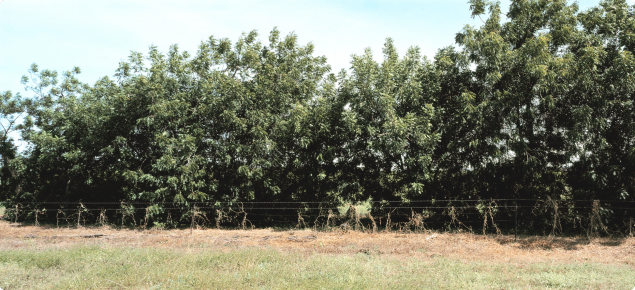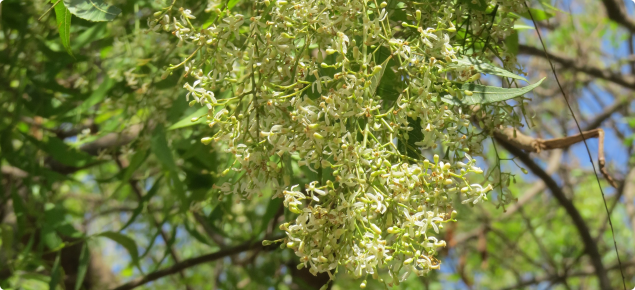Form: tree - perennial
Status: present in WA
Native to the Indian sub-continent (India and Bangladesh) and South-East Asia, this plant has escaped cultivation and is now established throughout Australia's northern tropics and subtropics of Queensland, the Northern Territory and Western Australia. In Western Australia, it is found in the Kimberley region, including Kununurra, Broome, Doon Doon, Kalumburu, Crossing Falls, Mud Springs, Packsaddle, Weaber Plains Road and Cave Springs.
Appearance
Neem is a fast-growing tree, generally 15–20m tall (sometimes up to 40m tall), with a crown diameter of up to 20m. This plant grows best in areas where annual rainfall is 450–1200mm. However, once established it is very drought tolerant. It is similar in appearance to the cape lilac or white cedar tree (Melia azedarach L.) which is in the same family (Meliaceae).
Leaves: Pinnate, compound leaves 20–40cm long, with 20 to 30 medium to dark green toothed leaflets about 3–8cm long and arranged in opposite pairs.
Flowers: White flowers 5–6mm long and 8–11mm grow in drooping axillary clusters from the stem. These branching inflorescences (up to 25cm long) can bear from 150 to 250 flowers.
Fruit: The fruit is an elongated, smooth olive-like stone fruit (drupe) about 1.4–2.8cm x 1.0–1.5cm. The fruit skin is thin and turns from green to yellow when ripe. The pulp is yellowish-white, 0.3–0.5cm thick and very fibrous.
Seeds: Fruits usually contain single brown-coated and elongated seed kernels. It rarely contains two or three seeds. This plant reproduces mainly from seeds, which are dispersed by fruit-eating birds and by water.
Agricultural and economic impact
Neem is a highly competitive weed thanks to its deep tap root system and extensive lateral roots, which produce suckers following damage to the roots. Neem has a detrimental impact upon terrestrial and riparian ecosystems, agricultural production and cultural sites.
In the Kimberley it has developed impenetrable forests along waterways, affecting access to infrastructure and channel reserves within the Ord River Irrigation Area (ORIA). It has also affected mustering in pastoral land and the management of Sandalwood farms.
Neem is dominating and killing iconic boab trees and mature gums, displacing nationally endangered monsoon vine thicket, and threatening endangered Purple-crowned fairywren habitat.
Although birds are known to gorge themselves on the fruits, the kernels contained in neem fruits are extremely poisonous to mammals.
Declared pest category
The Western Australian Organism List (WAOL) contains information on the area(s) in which this pest is declared and the control and keeping categories to which it has been assigned in Western Australia (WA). Search for neem in the WAOL using the scientific name Azadirachta indica.
Requirements for land owners/occupiers and other persons
Land owners/occupiers should refer to declared plant requirements if neem is found on their property.
Search > detect > report
| MyPestGuide™ Reporter | Pest and Disease Information Service (PaDIS) |
Control
Seedlings can be removed by hand but this is difficult for larger plants, as all roots and shoots must be completely removed. Mature trees can be controlled through the application of a suitable herbicide either as an application to cut stumps or as a basal bark treatment.
Control methods for this declared plant can be found through the neem control link.



